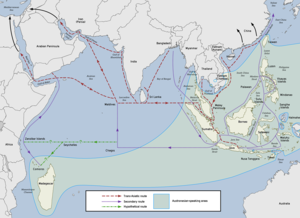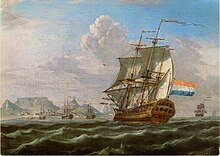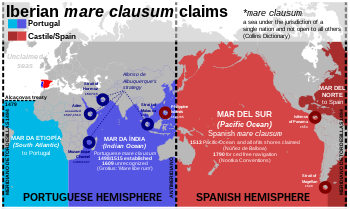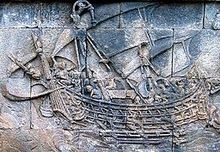Spice trade

Thespice tradeinvolved historical civilizations inAsia,Northeast AfricaandEurope.Spices such ascinnamon,cassia,cardamom,ginger,pepper,nutmeg,star anise,clove,andturmericwere known andused in antiquityand traded in theEastern World.[1]These spices found their way into theNear Eastbefore the beginning of the Christian era, with fantastic tales hiding their true sources.[1]
The maritime aspect of the trade was dominated by theAustronesian peoplesinSoutheast Asia,namely the ancient Indonesian sailors who established routes from Southeast Asia to Sri Lanka and India (and later China) by 1500 BC.[2]These goods were then transported by land towards the Mediterranean and theGreco-Roman worldvia theincense routeand theRoman–India routesbyIndianandPersiantraders.[3]The Austronesian maritime trade lanes later expanded into the Middle East and eastern Africa by the 1st millennium AD, resulting in the Austronesian colonization ofMadagascar.
Within specific regions, theKingdom of Axum(5th century BC–AD 11th century) had pioneered theRed Searoute before the 1st century AD. During the first millennium AD,Ethiopiansbecame the maritime trading power of theRed Sea.By this period, trade routes existed fromSri Lanka(the RomanTaprobane) and India, which had acquired maritime technology from early Austronesian contact. By mid-7th century AD, after therise of Islam,Arab traders started plying these maritime routes and dominated the westernIndian Oceanmaritime routes.[citation needed]
Arab traders eventually took over conveying goods via theLevantandVenetianmerchants toEuropeuntil the rise of theSeljuk Turksin 1090. Later theOttoman Turksheld the route again by 1453 respectively. Overland routes helped the spice trade initially, but maritimetrade routesled to tremendous growth in commercial activities to Europe.[citation needed]
The trade was changed by theCrusadesand later the EuropeanAge of Discovery,[4]during which the spice trade, particularly inblack pepper,became an influential activity for European traders.[5]From the 11th to the 15th centuries, the Italianmaritime republicsofVeniceandGenoamonopolized the trade between Europe and Asia.[6]TheCape Routefrom Europe to the Indian Ocean via theCape of Good Hopewas pioneered by the Portuguese explorer navigatorVasco da Gamain 1498, resulting in new maritime routes for trade.[7]
This trade, which drove world trade from the end of theMiddle Ageswell into theRenaissance,[5]ushered in an age of European domination in the East.[7]Channels such as theBay of Bengalserved as bridges for cultural and commercial exchanges between diverse cultures[4]as nations struggled to gain control of the trade along the many spice routes.[1]In 1571 the Spanish opened the first trans-Pacific route between its territories of the Philippines and Mexico, served by theManila Galleon.This trade route lasted until 1815. The Portuguese trade routes were mainly restricted and limited by the use of ancient routes, ports, and nations that were difficult to dominate. The Dutch were later able to bypass many of these problems by pioneering a direct ocean route from theCape of Good Hopeto theSunda StraitinIndonesia.
Origins[edit]

People from theNeolithicperiod traded inspices,obsidian,sea shells,precious stonesand other high-value materials as early as the 10th millennium BC. The first to mention the trade in historical periods are theEgyptians.In the 3rd millennium BC, they traded with theLand of Punt,which is believed to have been situated in an area encompassing northernSomalia,Djibouti,Eritreaand theRed Seacoast ofSudan.[8][9]


The spice trade was associated with overland routes early on, but maritime routes proved to be the factor which helped the trade grow.[1]The first true maritime trade network in the Indian Ocean was by theAustronesian peoplesofIsland Southeast Asia.[10]They established trade routes withSouthern IndiaandSri Lankafrom around 1500 BC to 600 BC, ushering an exchange of material culture (likecatamarans,outrigger boats,lashed-lugand sewn-plank boats, andpaan) andcultigens(likecoconuts,sandalwood,bananas,andsugarcane), as well as spicesendemicto theSpice Islands(clovesandnutmeg). It also connected the material cultures of India and China later on via the Maritime Silk Road.Indonesiansin particular were trading in spices (mainlycinnamonandcassia) withEast Africausingcatamaranand outrigger boats and sailing with the help of thewesterliesin the Indian Ocean. This trade network expanded to reach as far asAfricaand theArabian Peninsula,resulting in the Austronesian colonization ofMadagascarby the first half of the first millennium AD. It continued into historic times, later becoming theMaritime Silk Road.[11][12][10][13][14][15][16][17]
In the first millennium BC theArabs,Phoenicians,and Indians were also engaged in sea and land trade in luxury goods such as spices, gold, precious stones, leather of exotic animals, ebony and pearls. The sea trade was in theRed Seaand theIndian Ocean.The sea route in the Red Sea was fromBab-el-MandebtoBerenike,from there by land to theNile,and then by boats toAlexandria.Luxury goodsincluding Indian spices,ebony,silkand finetextileswere traded along the overlandincense route.[1]
In the second half of the first millennium BC theArab tribesof South and West Arabia took control over the land trade of spices fromSouth Arabiato theMediterranean Sea.These tribes were theM'ain,Qataban,Hadhramaut,SabaandHimyarite.In the north theNabateanstook control of the trade route that crossed theNegevfromPetratoGaza.The trade enriched these tribes.South Arabiawas calledEudaemon Arabia(the elated Arabia) by the Greeks and was on the agenda of conquests ofAlexander of Macedoniabefore he died. The Indians and the Arabs had control over the sea trade with India. In the late second century BC, theGreeksfrom thePtolemaic dynastyofEgyptlearned from the Indians how to sail directly fromAdento the west coast of India using the monsoon winds (as didHippalus) and took control of the sea trade via Red Sea ports.[18]
Spices are discussed in biblical narratives, and there is literary evidence for their use in ancient Greek and Roman society. There is a record fromTamiltexts of Greeks purchasing large sacks of black pepper from India, and many recipes in the 1st-centuryRoman cookbookApiciusmake use of the spice. The trade in spices lessened after thefall of the Roman Empire,but demand forginger,black pepper,cloves,cinnamonandnutmegrevived the trade in later centuries.[19]
Arab trade and medieval Europe[edit]

Rome played a part in the spice trade during the 5th century, but this role did not last through the Middle Ages.[1]The rise of Islam brought a significant change to the trade asRadhaniteJewish and Arab merchants, particularly fromEgypt,eventually took over conveying goods via theLevanttoEurope.At times, Jews enjoyed a virtual monopoly on the spice trade in large parts of Western Europe.[20]
The spice trade had brought great riches to theAbbasid Caliphateand inspired famous legends such as that ofSinbad the Sailor.These early sailors and merchants would often set sail from the port city ofBasraand, after many ports of call, would return to sell their goods, including spices, inBaghdad.The fame of many spices such asnutmegandcinnamonare attributed to these early spice merchants.[21][failed verification]
The Indian commercial connection with South East Asia proved vital to the merchants of Arabia andPersiaduring the 7th and 8th centuries.[22]Arab traders — mainly descendants of sailors fromYemenandOman— dominated maritime routes throughout the Indian Ocean, tapping source regions in theFar Eastand linking to the secret "spice islands" (Maluku IslandsandBanda Islands). The islands ofMoluccaalso find mention in several records: a Javanese chronicle (1365) mentions the Moluccas andMaloko,and navigational works of the 14th and 15th centuries contain the first unequivocal Arab reference to Moluccas. Sulaima al-Mahr writes: "East ofTimor[wheresandalwoodis found] are the islands ofBandamand they are the islands where nutmeg and mace are found. The islands ofclovesare calledMaluku..... "[23]
Moluccan products were shipped to trading emporiums in India, passing through ports likeKozhikodeinKeralaand throughSri Lanka.From there they were shipped westward across the ports of Arabia to the Near East, toOrmusin thePersian GulfandJeddahin theRed Seaand sometimes toEast Africa,where they were used for many purposes, including burial rites.[24]TheAbbasidsused Alexandria,Damietta,AdenandSirafas entry ports to trade with India and China.[25]Merchants arriving from India in the port city of Aden paid tribute in form ofmusk,camphor,ambergrisandsandalwoodtoIbn Ziyad,thesultanofYemen.[25]
Indian spice exports find mention in the works of Ibn Khurdadhbeh (850), al-Ghafiqi (1150), Ishak bin Imaran (907) and Al Kalkashandi (14th century).[24]Chinese travelerXuanzangmentions the town ofPuriwhere "merchants depart for distant countries."[26]

From there, overland routes led to the Mediterranean coasts. From the 8th until the 15th century,maritime republics(Republic of Venice,Republic of Pisa,Republic of Genoa,Duchy of Amalfi,Duchy of Gaeta,Republic of AnconaandRepublic of Ragusa[27]) held a monopoly on European trade with the Middle East. The silk and spice trade, involvingspices,incense,herbs,drugsandopium,made these Mediterranean city-states extremely wealthy. Spices were among the most expensive and in-demand products of the Middle Ages, used inmedicineas well as in the kitchen. They were all imported from Asia and Africa. Venetian and other navigators of maritime republics then distributed the goods through Europe.
TheOttoman Empire,after thefall of Constantinoplein 1453, barred Europeans from important combined land-sea routes.[28]
Age of Discovery: a new route and a New World[edit]


TheRepublic of Venicehad become a formidable power and a key player in the Eastern spice trade.[29]Other powers, in an attempt to break the Venetian hold on spice trade, began to build up maritime capability.[1]Until the mid-15th century, trade with the East was achieved through theSilk Road,with theByzantine Empireand theItalian city-statesofVeniceandGenoaacting as middlemen.
In 1453, however, theOttoman Empiretook control of the sole spice trade route that existed at the time after thefall of Constantinople,and were in a favorable position to charge hefty taxes on merchandise bound for the west. The Western Europeans,[which?]not wanting to be dependent on an expansionist, non-Christian power for the lucrative commerce with the East, set out to find an alternative route by sea aroundAfrica.[citation needed]
The first country to attempt to circumnavigate Africa was Portugal, which had, since the early 15th century, begun to explore northern Africa underHenry the Navigator.Emboldened by these early successes and eyeing a lucrative monopoly on a possible sea route to theIndies,the Portuguese first rounded theCape of Good Hopein 1488 on an expedition led byBartolomeu Dias.[30]Just nine years later in 1497, on the orders ofManuel I of Portugal,four vessels under the command of navigatorVasco da Gamacontinued beyond to the eastern coast of Africa toMalindiand sailed across theIndian OceantoCalicut,on theMalabar CoastinKerala[7]inSouth India— the capital of the localZamorinrulers. The wealth of theIndieswas now open for the Europeans to explore; thePortuguese Empirewas the earliest European seaborne empire to grow from the spice trade.[7]

In 1511,Afonso de AlbuquerqueconqueredMalaccafor Portugal, then the center of Asian trade. East of Malacca, Albuquerque sent several diplomatic and exploratory missions, including to the Moluccas. Learning the secret location of theSpice Islands,mainly the Banda Islands, then the world source of nutmeg, he sent an expedition led byAntónio de Abreuto Banda, where they were the first Europeans to arrive, in early 1512.[31]Abreu's expedition reachedBuru,AmbonandSeramIslands, and then Banda.

From 1507 to 1515 Albuquerque tried to completely block Arab and other traditional routes that stretched from the shores of Western Pacific to the Mediterranean Sea, through the conquest of strategic bases in the Persian Gulf and at the entry of the Red Sea.[citation needed]
By the early 16th century the Portuguese had complete control of the African sea route, which extended through a long network of routes that linked three oceans, from the Moluccas (the Spice Islands) in the Pacific Ocean limits, through Malacca,Keralaand Sri Lanka, toLisbonin Portugal.[citation needed]
TheCrown of Castilehad organized the expedition ofChristopher Columbusto compete with Portugal for the spice trade with Asia, but when Columbus landed on the island ofHispaniola(in what is nowHaiti) instead of in theIndies,the search for a route to Asia was postponed until a few years later. AfterVasco Núñez de Balboacrossed theIsthmus of Panamain 1513, the Spanish Crown prepared awestward voyagebyFerdinand Magellanin order to reach Asia from Spain across the Atlantic and Pacific Oceans. On October 21, 1520, his expedition crossed theStrait of Magellanin the southern tip of South America, opening the Pacific to European exploration. On March 16, 1521, the ships reached thePhilippinesand soon after the Spice Islands, ultimately resulting decades later in theManila Galleontrade, the first westward spice trade route to Asia. After Magellan's death in the Philippines, navigatorJuan Sebastian Elcanotook command of the expedition and drove it across the Indian Ocean and back to Spain, where they arrived in 1522 aboard the last remaining ship, theVictoria.For the next two-and-a-half centuries, Spain controlled a vast trade network that linked three continents: Asia, the Americas and Europe. A global spice route had been created: fromManilain the Philippines (Asia) toSevillein Spain (Europe), viaAcapulcoinMexico(North America).[citation needed]
Cultural diffusion[edit]

One of the most important technological exchanges of the spice trade network was the early introduction of maritime technologies to India, the Middle East, East Africa, and China by theAustronesian peoples.These technologies include the plank-sewn hulls,catamarans,outrigger boats,and possibly thelateen sail.This is still evident in Sri Lankan and South Indian languages. For example,Tamilpaṭavu,Telugupaḍava,andKannadapaḍahu,all meaning "ship", are all derived fromProto-Hesperonesian*padaw,"sailboat", with Austronesian cognates likeJavaneseperahu,Kadazanpadau,Maranaopadaw,Cebuanoparáw,Samoanfolau,Hawaiianhalau,andMāoriwharau.[14][13][15]
Austronesians also introduced manyAustronesiancultigensto southern India, Sri Lanka, and eastern Africa that figured prominently in the spice trade.[32]They includebananas,[33]Pacific domesticatedcoconuts,[34][35]Dioscoreayams,[36]wetland rice,[33]sandalwood,[37]giant taro,[38]Polynesian arrowroot,[39]ginger,[40]lengkuas,[32]tailed pepper,[41]betel,[12]areca nut,[12]andsugarcane.[42][43]
HinduandBuddhistreligious establishments of Southeast Asia came to be associated with economic activity and commerce as patrons, entrusted large funds which would later be used to benefit local economies by estate management, craftsmanship, and promotion of trading activities.[44]Buddhism,in particular, traveled alongside the maritime trade, promoting coinage, art, and literacy.[45]Islamspread throughout the East, reachingmaritime Southeast Asiain the 10th century; Muslim merchants played a crucial part in the trade.[46]Christian missionaries, such asSaint Francis Xavier,were instrumental in the spread ofChristianityin the East.[46]Christianity competed with Islam to become the dominant religion of the Moluccas.[46]However, the natives of the Spice Islands accommodated to aspects of both religions easily.[47]
The Portuguese colonial settlements saw traders such as the Gujaratibanias,South IndianChettis,Syrian Christians,Chinese fromFu gianprovince, and Arabs fromAdeninvolved in the spice trade.[48]Epics, languages, and cultural customs were borrowed by Southeast Asia from India, and later China.[4]Knowledge ofPortuguese languagebecame essential for merchants involved in the trade.[49]The colonial pepper trade drastically changed the experience of modernity in Europe, and in Kerala and it brought, along with colonialism, early capitalism to India's Malabar Coast, changing cultures of work and caste.[50]
Indian merchants involved in spice trade tookIndian cuisineto Southeast Asia, notably present dayMalaysiaandIndonesia,where spice mixtures andblack pepperbecame popular.[51]Conversely, Southeast Asian cuisine and crops was also introduced to India and Sri Lanka, whererice cakesandcoconut milk-based dishes are still dominant.[32][34][33][40][52]
European people intermarried with Indians and popularized valuable culinary skills, such asbaking,in India.[53]Indian food, adapted to the European palate, became visible in England by 1811 as exclusive establishments began catering to the tastes of both the curious and those returning from India.[54]Opium was a part of the spice trade, and some people involved in the spice trade were driven by opium addiction.[55][56]
See also[edit]
References[edit]
- ^abcdefg"Spice Trade".Encyclopædia Britannica. 2016.Retrieved25 April2016.
- ^Dick-Read, Robert (July 2006)."Indonesia and Africa: questioning the origins of some of Africa's most famous icons".The Journal for Transdisciplinary Research in Southern Africa.2(1): 23–45.doi:10.4102/td.v2i1.307.
- ^Fage 1975: 164
- ^abcDonkin 2003
- ^abCorn & Glasserman 1999: Prologue
- ^"Brainy IAS - Online & Offline Classes".Brainy IAS.2018-03-03.Retrieved2021-09-22.
- ^abcdGama, Vasco da. The Columbia Encyclopedia, Sixth Edition. Columbia University Press.
- ^Simson Najovits,Egypt, trunk of the tree, Volume 2,(Algora Publishing: 2004), p. 258.
- ^Rawlinson 2001: 11-12
- ^abcManguin, Pierre-Yves (2016)."Austronesian Shipping in the Indian Ocean: From Outrigger Boats to Trading Ships".In Campbell, Gwyn (ed.).Early Exchange between Africa and the Wider Indian Ocean World.Palgrave Macmillan. pp. 51–76.ISBN9783319338224.
- ^Olivera, Baldomero; Hall, Zach; Granberg, Bertrand (31 March 2024). "Reconstructing Philippine history before 1521: the Kalaga Putuan Crescent and the Austronesian maritime trade network".SciEnggJ.17(1): 71–85.doi:10.54645/2024171ZAK-61.
- ^abcZumbroich, Thomas J. (2007–2008)."The origin and diffusion of betel chewing: a synthesis of evidence from South Asia, Southeast Asia and beyond".eJournal of Indian Medicine.1:87–140.Archivedfrom the original on 23 March 2019.Retrieved22 January2019.
- ^abDoran, Edwin Jr. (1974)."Outrigger Ages".The Journal of the Polynesian Society.83(2): 130–140.
- ^abMahdi, Waruno (1999). "The Dispersal of Austronesian boat forms in the Indian Ocean". In Blench, Roger; Spriggs, Matthew (eds.).Archaeology and Language III: Artefacts languages, and texts.One World Archaeology. Vol. 34. Routledge. pp. 144–179.ISBN0415100542.[dead link]
- ^abDoran, Edwin B. (1981).Wangka: Austronesian Canoe Origins.Texas A&M University Press.ISBN9780890961070.
- ^Blench, Roger (2004)."Fruits and arboriculture in the Indo-Pacific region".Bulletin of the Indo-Pacific Prehistory Association.24(The Taipei Papers (Volume 2)): 31–50.
- ^Daniels, Christian; Menzies, Nicholas K. (1996). Needham, Joseph (ed.).Science and Civilisation in China: Volume 6, Biology and Biological Technology, Part 3, Agro-Industries and Forestry.Cambridge University Press. pp. 177–185.ISBN9780521419994.
- ^Shaw 2003: 426
- ^The Medieval Spice Trade and the Diffusion of the ChileGastronomicaSpring 2007 Vol. 7 Issue 2
- ^Rabinowitz, Louis (1948).Jewish Merchant Adventurers: A Study of the Radanites.London: Edward Goldston. pp. 150–212.
- ^"The Third Voyage of Sindbad the Seaman – The Arabian Nights – The Thousand and One Nights – Sir Richard Burton translator".Classiclit.about. 2009-11-02.Retrieved2011-09-16.
- ^Donkin 2003: 59
- ^Donkin 2003: 88
- ^abDonkin 2003: 92
- ^abDonkin 2003: 91–92
- ^Donkin 2003: 65
- ^Armando Lodolini,Le repubbliche del mare,Roma, Biblioteca di storia patria, 1967.
- ^"International School History - MYP History".internationalschoolhistory.net.Retrieved2020-05-25.
- ^Pollmer, Priv.Doz. Dr. Udo."The spice trade and its importance for European expansion".Migration and Diffusion.Retrieved27 June2016.
- ^Catholic Encyclopedia: Bartolomeu DiasRetrieved November 29, 2007
- ^Nathaniel's Nutmeg: How One Man's Courage Changed the Course of History,Milton, Giles (1999), pp. 5–7
- ^abcHoogervorst, Tom (2013)."If Only Plants Could talk...: Reconstructing Pre-Modern Biological Translocations in the Indian Ocean"(PDF).In Chandra, Satish; Prabha Ray, Himanshu (eds.).The Sea, Identity and History: From the Bay of Bengal to the South China Sea.Manohar. pp. 67–92.ISBN9788173049866.
- ^abcLockard, Craig A. (2010).Societies, Networks, and Transitions: A Global History.Cengage Learning. pp. 123–125.ISBN9781439085202.
- ^abGunn, Bee F.; Baudouin, Luc; Olsen, Kenneth M.; Ingvarsson, Pär K. (22 June 2011)."Independent Origins of Cultivated Coconut (Cocos nucifera L.) in the Old World Tropics".PLOS ONE.6(6): e21143.Bibcode:2011PLoSO...621143G.doi:10.1371/journal.pone.0021143.PMC3120816.PMID21731660.
- ^Crowther, Alison; Lucas, Leilani; Helm, Richard; Horton, Mark; Shipton, Ceri; Wright, Henry T.; Walshaw, Sarah; Pawlowicz, Matthew; Radimilahy, Chantal; Douka, Katerina; Picornell-Gelabert, Llorenç; Fuller, Dorian Q.; Boivin, Nicole L. (14 June 2016)."Ancient crops provide first archaeological signature of the westward Austronesian expansion".Proceedings of the National Academy of Sciences.113(24): 6635–6640.Bibcode:2016PNAS..113.6635C.doi:10.1073/pnas.1522714113.PMC4914162.PMID27247383.
- ^Barker, Graeme; Hunt, Chris; Barton, Huw; Gosden, Chris; Jones, Sam; Lloyd-Smith, Lindsay; Farr, Lucy; Nyirí, Borbala; O'Donnell, Shawn (August 2017)."The 'cultured rainforests' of Borneo"(PDF).Quaternary International.448:44–61.Bibcode:2017QuInt.448...44B.doi:10.1016/j.quaint.2016.08.018.
- ^Fox, James J. (2006).Inside Austronesian Houses: Perspectives on Domestic Designs for Living.ANU E Press. p. 21.ISBN9781920942847.
- ^Matthews, Peter J. (1995)."Aroids and the Austronesians".Tropics.4(2/3): 105–126.doi:10.3759/tropics.4.105.
- ^Spennemann, Dirk H.R. (1994). "Traditional Arrowroot Production and Utilization in the Marshall Islands".Journal of Ethnobiology.14(2): 211–234.
- ^abViestad A (2007).Where Flavor Was Born: Recipes and Culinary Travels Along the Indian Ocean Spice Route.San Francisco:Chronicle Books.p. 89.ISBN9780811849654.
- ^Ravindran, P.N. (2017).The Encyclopedia of Herbs and Spices.CABI.ISBN9781780643151.
- ^Daniels, John; Daniels, Christian (April 1993). "Sugarcane in Prehistory".Archaeology in Oceania.28(1): 1–7.doi:10.1002/j.1834-4453.1993.tb00309.x.
- ^Paterson, Andrew H.; Moore, Paul H.; Tom L., Tew (2012)."The Gene Pool ofSaccharumSpecies and Their Improvement ".In Paterson, Andrew H. (ed.).Genomics of the Saccharinae.Springer Science & Business Media. pp. 43–72.ISBN9781441959478.
- ^Donkin 2003: 67
- ^Donkin 2003: 69
- ^abcCorn & Glasserman 1999
- ^Corn & Glasserman 1999: 105
- ^Collingham 56: 2006
- ^Corn & Glasserman 1999: 203
- ^Vinod Kottayil Kalidasan, 'The Routes of Pepper: Colonial Discourses around the Spice Trade in Malabar', Kerala Modernity: Ideasa, Spaces and Practices in Transition, Ed. Shiju Sam Varughese and Satheese Chandra Bose, New Delhi: Orient Blackswan, 2015. For the link:"Orient Blackswan PVT. LTD".Archived fromthe originalon 2015-04-13.Retrieved2015-04-13.
- ^Collingham 245: 2006
- ^Dalby A (2002).Dangerous Tastes: The Story of Spices.University of California Press.ISBN9780520236745.
- ^Collingham 61: 2006
- ^Collingham 129: 2006
- ^"Opium Throughout History | The Opium Kings | FRONTLINE | PBS".pbs.org.Retrieved2018-04-13.
- ^Burger, M. (2003), The Forgotten Gold? The Importance of the Dutch opium trade in the Seventeenth Century
Bibliography[edit]
- Collingham, Lizzie (December 2005).Curry: A Tale of Cooks and Conquerors.Oxford University Press.ISBN978-0195172416.
- Corn, Charles; Debbie Glasserman (March 1999).The Scents of Eden: A History of the Spice Trade.Kodansha America.ISBN978-1568362496.
- Donkin, Robin A.(August 2003).Between East and West: The Moluccas and the Traffic in Spices Up to the Arrival of Europeans.Diane Publishing Company.ISBN978-0871692481.
- Fage, John Donnelly;et al. (1975).The Cambridge History of Africa.Cambridge University Press.ISBN978-0521215923.
- Rawlinson, Hugh George (2001).Intercourse Between India and the Western World: From the Earliest Times of the Fall of Rome.Asian Educational Services.ISBN978-8120615496.
- Shaw, Ian(2003).The Oxford History of Ancient Egypt.Oxford University Press.ISBN978-0192804587.
- Kalidasan, Vinod Kottayil (2015)."Routes of Pepper: Colonial Discourses around Spice Trade in Malabar" in Kerala Modernity: Ideas, Spaces and Practices in Transition, Shiju Sam Varughese and Sathese Chandra Bose (Eds).Orient Blackswan, New Delhi.ISBN978-81-250-5722-2.
Further reading[edit]
- Borschberg, Peter (2017), "The Value of Admiral Matelieff's Writings for Studying the History of Southeast Asia, c. 1600–1620".Journal of Southeast Asian Studies48(3): 414–435.doi:10.1017/S002246341700056X.
- Keay, John (2006).The Spice Route: A History.University of California Press.
- Nabhan, Gary Paul:Cumin, Camels, and Caravans: A Spice Odyssey.[History of Spice Trade] University of California Press, 2014.ISBN978-0-520-26720-6[Print];ISBN978-0-520-95695-7[eBook]
- Pavo López, Marcos:Spices in maps. Fifth centenary of the first circumnavigation of the world.[History of the spice trade through old maps] e-Perimetron, vol 15, no.2 (2020)
External links[edit]
![]() Media related toSpice tradeat Wikimedia Commons
Media related toSpice tradeat Wikimedia Commons
- Spices
- History of international trade
- Trade routes
- Medieval economic history
- Age of Discovery
- Portuguese exploration in the Age of Discovery
- Economic history of Portugal
- Economic history of India
- Economic history of Spain
- Portuguese Empire
- Spanish Empire
- Ancient Somalia
- Kingdom of Aksum
- Age of Sail
- Trade by commodity
- Maluku Islands






